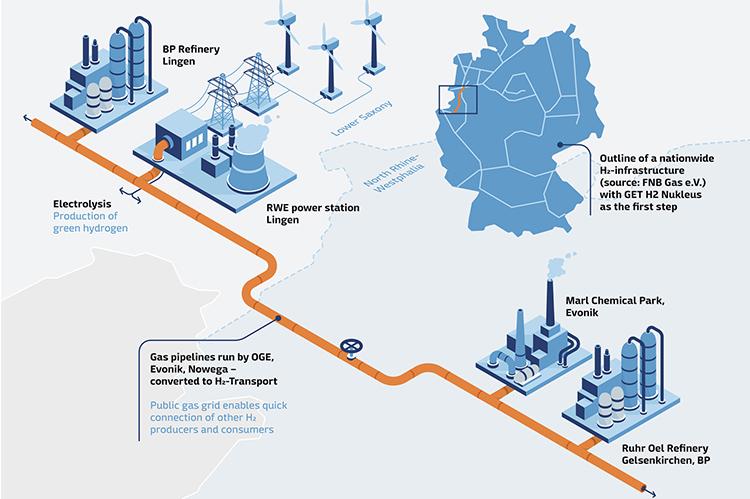First Publicly Accessible Hydrogen Network Will Allow Wide-ranging CO2 Reduction
Publicly accessible hydrogen network GET H2 Nukleus is due to supply increasing quantities of green hydrogen (H2) to industrial companies in Lower Saxony and North Rhine-Westphalia from late 2022 onwards. BP, Evonik, Nowega, OGE and RWE Generation have signed a Memorandum of Understanding to develop the GET H2 Nukleus project.

Germany’s first publicly accessible hydrogen network is due to supply increasing quantities of green hydrogen (H2) to industrial companies in Lower Saxony and North Rhine-Westphalia from late 2022 onwards. BP, Evonik, Nowega, OGE and RWE Generation have signed a Memorandum of Understanding to develop the GET H2 Nukleus project. All these companies are members of the GET H2 initiative
There are high hopes for green hydrogen in the energy transition. The idea is to convert power from renewable energies into hydrogen and use it as a carbon-free source of energy in industry and other sectors. An expansion of the relevant infrastructure is key to transporting green hydrogen in Germany.
The green hydrogen is to be produced from renewable energies in Lingen, in Lower Saxony, in an 100 MW electrolyser owned by RWE Generation. It will then be transported to industrial customers and refineries in Lingen, Marl and Gelsenkirchen – mainly via existing gas pipelines operated by transmission system operators Nowega and OGE and converted for the transportation of 100 percent hydrogen, but also via a partially new construction by Evonik. Access to this hydrogen network is to be open in a nondiscriminatory way to all generators, traders or consumers, as is already the case with power grids and gas networks. This will make a rapid, reliable integration of further hydrogen projects possible.
In building such infrastructure, the project partners are paving the way for a sustainable national hydrogen sector and a leading technological role for Germany in it. What is important in the view of the project partners is that politicians should create the necessary legal conditions to enable all companies involved in hydrogen projects to rapidly expand their production of green hydrogen and of the relevant hydrogen infrastructure, as well as providing a secure basis for investment.
In supplying refineries and chemical parks, GET H2 Nukleus kicks in where green hydrogen can make the fastest contribution to a low-carbon future. These companies already use large quantities of hydrogen in their production processes and will significantly reduce their carbon emissions by switching over to green hydrogen. Building up a hydrogen infrastructure based on the existing gas infrastructure will guarantee for industrial customers precisely the security of supplies which they are dependent upon. In the longer term, existing cavern storage facilities along the hydrogen pipeline are to be incorporated which will further increase this security of supplies. Production of green hydrogen and supply to customers is to start by the end of 2022 if possible, provided that this is economically viable and the political conditions are right by then.

